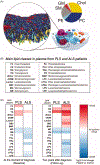Better understanding the neurobiology of primary lateral sclerosis
- PMID: 33602014
- PMCID: PMC8016556
- DOI: 10.1080/21678421.2020.1837175
Better understanding the neurobiology of primary lateral sclerosis
Abstract
Primary lateral sclerosis (PLS) is a rare neurodegenerative disease characterized by progressive degeneration of upper motor neurons (UMNs). Recent studies shed new light onto the cellular events that are particularly important for UMN maintenance including intracellular trafficking, mitochondrial energy homeostasis and lipid metabolism. This review summarizes these advances including the role of Alsin as a gene linked to atypical forms of juvenile PLS, and discusses wider aspects of cellular pathology that have been observed in adult forms of PLS. The review further discusses the prospects of new transgenic upper motor neuron reporter mice, human stem cell-derived UMN cultures, cerebral organoids and non-human primates as future model systems to better understand and ultimately treat PLS.
Keywords: ALS2; Alsin; Betz cell; Golgi apparatus; bioenergetics; corticospinal motor neuron; endosomes; membrane lipids; mitochondria; primary lateral sclerosis; upper motor neuron.
Conflict of interest statement
Declaration of interest
The authors report no conflicts of interest. The authors alone are responsible for the content and writing of this article.
Figures





Similar articles
-
Absence of alsin function leads to corticospinal motor neuron vulnerability via novel disease mechanisms.Hum Mol Genet. 2016 Mar 15;25(6):1074-87. doi: 10.1093/hmg/ddv631. Epub 2016 Jan 10. Hum Mol Genet. 2016. PMID: 26755825 Free PMC article.
-
Importance of lipids for upper motor neuron health and disease.Semin Cell Dev Biol. 2021 Apr;112:92-104. doi: 10.1016/j.semcdb.2020.11.004. Epub 2020 Dec 13. Semin Cell Dev Biol. 2021. PMID: 33323321 Free PMC article. Review.
-
ALS2/alsin knockout mice and motor neuron diseases.Neurodegener Dis. 2008;5(6):359-66. doi: 10.1159/000151295. Epub 2008 Aug 20. Neurodegener Dis. 2008. PMID: 18714162 Free PMC article. Review.
-
Genotype-phenotype correlation in seven motor neuron disease families with novel ALS2 mutations.Am J Med Genet A. 2021 Feb;185(2):344-354. doi: 10.1002/ajmg.a.61951. Epub 2020 Nov 5. Am J Med Genet A. 2021. PMID: 33155358
-
Alsin and the molecular pathways of amyotrophic lateral sclerosis.Mol Neurobiol. 2007 Dec;36(3):224-31. doi: 10.1007/s12035-007-0034-x. Epub 2007 Jul 10. Mol Neurobiol. 2007. PMID: 17955197 Free PMC article. Review.
Cited by
-
Mutations and Protein Interaction Landscape Reveal Key Cellular Events Perturbed in Upper Motor Neurons with HSP and PLS.Brain Sci. 2021 Apr 29;11(5):578. doi: 10.3390/brainsci11050578. Brain Sci. 2021. PMID: 33947096 Free PMC article.
-
Primary Lateral Sclerosis: An Overview.J Clin Med. 2024 Jan 19;13(2):578. doi: 10.3390/jcm13020578. J Clin Med. 2024. PMID: 38276084 Free PMC article. Review.
-
NAD+ Metabolism and Diseases with Motor Dysfunction.Genes (Basel). 2021 Nov 9;12(11):1776. doi: 10.3390/genes12111776. Genes (Basel). 2021. PMID: 34828382 Free PMC article. Review.
-
Neuroaxonal Degeneration as a Converging Mechanism in Motor Neuron Diseases (MNDs): Molecular Insights into RNA Dysregulation and Emerging Therapeutic Targets.Int J Mol Sci. 2025 Aug 7;26(15):7644. doi: 10.3390/ijms26157644. Int J Mol Sci. 2025. PMID: 40806770 Free PMC article. Review.
References
-
- Erb WH. Ueber einen wenig bekanten spinalen Symptomenkomplex. About a little-known spinal symptom complex. Berliner Klinische Wochenschrift 1875;26:357–9.
-
- Stark FM, Moersch FP. Primary lateral sclerosis. A distinct clinical entity. J Nerv Mental Dis. 1945;102:332–7.
-
- Pringle CE, Hudson AJ, Munoz DG, Kiernan JA, Brown WF, Ebers GC. Primary lateral sclerosis. Clinical features, neuropathology and diagnostic criteria. Brain 1992;115: 495–520. - PubMed
-
- Gordon PH, Cheng B, Katz IB, Pinto M, Hays AP, Mitsumoto H, et al. The natural history of primary lateral sclerosis. Neurology 2006;66:647–53. - PubMed
Publication types
MeSH terms
Substances
Grants and funding
LinkOut - more resources
Full Text Sources
Medical
Molecular Biology Databases
